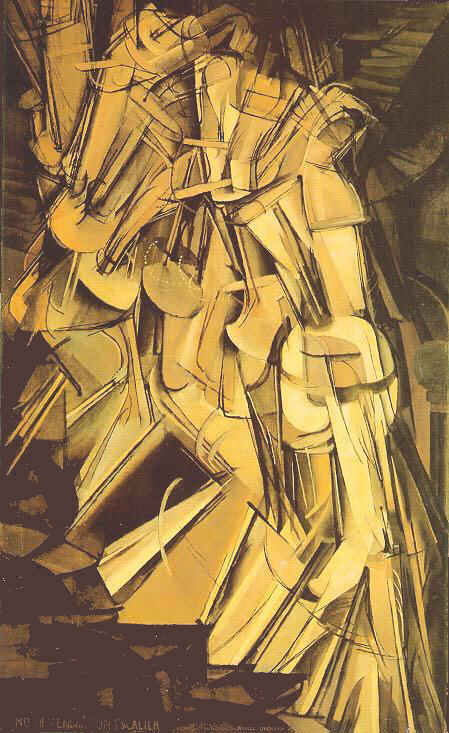 ^
18 February 1913 French painting Nude
Descending a Staircase No.2 (1912) by Marcel Duchamp, causes a scandal
at the 1913 Armory Show in
New York City. ^
18 February 1913 French painting Nude
Descending a Staircase No.2 (1912) by Marcel Duchamp, causes a scandal
at the 1913 Armory Show in
New York City.
A major proponent of Dada, Duchamp was one
of the most influential figures of avant-garde 20th-century art.
Marcel Duchamp (28 July 1887 - 2 October
1968) was a French painter and theorist, a major proponent of DADA, and
one of the most influential figures of avant-garde 20th-century art. After
a brief early period in which he was influenced chiefly by Paul Cézanne
and Fauve color, Duchamp developed a type of symbolic painting, a dynamic
version of facet Cubism, in which the image depicted successive movements
of a single body.
It closely resembled the multiple exposure
photography documented in Eadweard Muybridge's book The Horse in Motion
(1878). In 1912, Duchamp painted his famous Nude Descending A Staircase,
which caused a scandal at the 1913 Armory show in New York City. In the
same year he developed, with Francis Picabia and Guillaume Apollinaire,
the radical and ironic ideas that independently prefigured the official
founding of Dada in 1916 in Zurich.
In Paris in 1914, Duchamp bought and inscribed
a bottle rack, thereby producing his first ready-made, a new art form based
on the principle that art does not depend on established rules or on craftsmanship.
Duchamp's ready-mades are ordinary objects that are signed and titled, becoming
aesthetic, rather than functional, objects simply by this change in context.
Dada aimed at departure from the physical aspect of painting and emphases
in ideas as the chief means of artistic expression.
In 1915, Duchamp moved to New York City,
where he was befriended by Louise and Walter Arensberg and their circle
of artists and poets, which constituted New York Dada. That same year he
began his major work, The Large Glass, or The Bride Stripped Bare by
Her Bachelors, Even (1915-23), a construction of wire and painted foil
fitted between plates of transparent glass. In 1918 he completed his last
major painting, Tu m', a huge oil and graphite on canvas, a unique
combination of real and painted objects and illusionistic and flat space.
Following his maxim never to repeat himself,
Duchamp "stopped" painting (1923) after 20 works and devoted himself largely
to the game of chess. |
^
Marcel Duchamp, French US Dadaist
Surrealist,
born in 1887, died in 1968, brother of Raymond
Duchamp-Villon, half-brother of Jacques
Villon.
— Broke down the boundaries between works of art and everyday objects.
Became an American citizen in 1947. His grandfather, his brothers, Jacques
Villon, and Raymond Duchamp-Villon, and his sister, Suzanne Duchamp, were
all artists. The three brothers agreed ca. 1901 to use different names professionally.
Went to Paris in 1903 and studied at the Academie Julian, and did cartoons
for the "Courrier FranÁaise" and "Le Rire" between 1905 and 1910. Knew Apollinaire
and other artists involved in the Cubist movement. He also met Picabia,
who later founded American Dada. In 1913 Duchamp abandoned conventional
media and became interested in three-dimensional objects and "ready-mades."
He aimed (unsuccessfully as he himself admitted) to take away the mystique
of taste and destroy the concept of aesthetic beauty in art. Duchamp's "Nude
Descending a Staircase" created a major stir at the Armory Show in 1913.
After that time he painted few other pictures. His irreverence for conventional
aesthetic standards led him to devise his famous ready-mades and heralded
an artistic revolution. Thus when he arrived in America in 1915 he was already
notorious. In 1923 Duchamp retired from work as an artist, although he collaborated
with Man Ray on some experimental films and continued to organize exhibitions.
Duchamp was friendly with the Dadaists, and in the 1930s he helped to organize
Surrealist exhibitions. The Pompidou Center in Paris opened with a retrospective
of Duchamp's work in 1977.
—
LINKS — Un
site Duchamp — Portrait
of his father
Marcel
naît le 28 Jul 1887 vers 14 heures, d'une mère normande et d'un père notaire.
Commence
à peindre, dès 1902, vers 15 ans, des paysages (normands -églises, meules,
pivoines, pommiers) à l'ambiance impressionniste puis quelques portraits.
  Il rejoint ses frères à Paris en 1904.
Vend des dessins humoristiques au Courrier français et Le Sourire. Il continue
à peindre et à assimiler les influences de l'époque. Il rejoint ses frères à Paris en 1904.
Vend des dessins humoristiques au Courrier français et Le Sourire. Il continue
à peindre et à assimiler les influences de l'époque.
 "1909 et 1910 furent les années de ma découverte de Cézanne,
qui n'était reconnu alors que d'une minorité. Ce portrait
[de son père] fut exécuté en 1910 et est une illustration typique de mon
culte pour Cézanne allié à mon amour filial". "1909 et 1910 furent les années de ma découverte de Cézanne,
qui n'était reconnu alors que d'une minorité. Ce portrait
[de son père] fut exécuté en 1910 et est une illustration typique de mon
culte pour Cézanne allié à mon amour filial".
Après avoir épuisé les ressources de la leçon cézanienne, il s'intéresse
aux Fauves:
Matisse,
Derain,
Braque,
van
Dongen.
1911
S'intéresse en même temps au cubisme et à la représentation du mouvement.
Oeuvres de plus en plus personnelles, comme Jeune homme triste dans un train
ou Moulin à café
 "Mon frère avait une cuisine dans sa petite
maison de Puteaux et il a eu l'idée de la décorer avec des tableaux des
copains. Il a demandé à Gleizes,
Metzinger,
La
Fresnaye, Léger
aussi je crois, de lui faire des petits tableaux de la même dimension, comme
une sorte de frise. Il s'est également adressé à moi et j'ai exécuté un
moulin à café que j'ai fait éclater; la poudre tombe à
côté, les engrenages sont en haut et la poignée est vue simultanément à
plusieurs points de son circuit avec une flèche pour indiquer le mouvement.
Sans le savoir, j'avais ouvert une fenêtre sur quelque chose d'autre. "Mon frère avait une cuisine dans sa petite
maison de Puteaux et il a eu l'idée de la décorer avec des tableaux des
copains. Il a demandé à Gleizes,
Metzinger,
La
Fresnaye, Léger
aussi je crois, de lui faire des petits tableaux de la même dimension, comme
une sorte de frise. Il s'est également adressé à moi et j'ai exécuté un
moulin à café que j'ai fait éclater; la poudre tombe à
côté, les engrenages sont en haut et la poignée est vue simultanément à
plusieurs points de son circuit avec une flèche pour indiquer le mouvement.
Sans le savoir, j'avais ouvert une fenêtre sur quelque chose d'autre.
 Cette
flèche était une innovation qui me plaisait beaucoup, le côté diagrammatique
était intéressant du point de vue esthétique." Cette
flèche était une innovation qui me plaisait beaucoup, le côté diagrammatique
était intéressant du point de vue esthétique."
1912
  Mars 1912: c'est l'incident du Nu
descendant un escalier. Mars 1912: c'est l'incident du Nu
descendant un escalier.
Il envoie au Salon des Indépendants sa version aboutie d'un Nu étudié l'année
précédente. Ce nu est destiné à être accroché parmi les oeuvres des membres
du Groupe de Puteaux, dont font partie Gleizes, Metzinger et deux frères
de Marcel, Jacques Villon et Raymond Duchamp-Villon, partisans du cubisme
'raisonnable'.
 Malaise
pendant l'accrochage, son Nu pose un problème. Ses collègues n'en trouvent
pas le sujet conforme à leur cubisme (pas de nu, et encore moins qui descende
un escalier). Ses deux frères sont délégués chez Marcel pour lui demander
de bien vouloir au moins en changer le titre. Marcel prend mal cette manifestation
de rigidité et vient récupérer son tableau, en fiacre. Malaise
pendant l'accrochage, son Nu pose un problème. Ses collègues n'en trouvent
pas le sujet conforme à leur cubisme (pas de nu, et encore moins qui descende
un escalier). Ses deux frères sont délégués chez Marcel pour lui demander
de bien vouloir au moins en changer le titre. Marcel prend mal cette manifestation
de rigidité et vient récupérer son tableau, en fiacre.
 À partir de ce moment, il s'éloigne
des peintres professionnels et se trouve un travail -bibliothécaire à Sainte
Geneviève. Il ne renonce pas pour autant à faire l'artiste, mais ça sera
désormais selon ses règles à lui. À partir de ce moment, il s'éloigne
des peintres professionnels et se trouve un travail -bibliothécaire à Sainte
Geneviève. Il ne renonce pas pour autant à faire l'artiste, mais ça sera
désormais selon ses règles à lui.
 Début juin, il assiste en compagnie d'Appolinaire
à l'une des rares et tumultueuses représentations des Impressions
d'Afriques de Raymond Roussel, qui suscite l'enthousiasme de ses
25 ans et oriente son travail vers des directions radicalement nouvelles. Début juin, il assiste en compagnie d'Appolinaire
à l'une des rares et tumultueuses représentations des Impressions
d'Afriques de Raymond Roussel, qui suscite l'enthousiasme de ses
25 ans et oriente son travail vers des directions radicalement nouvelles.
 "C'est Roussel qui, fondamentalement,
fut responsable de mon Verre. Ce furent ses Impressions d'Afriques qui m'indiquèrent
dans ses grandes lignes la démarche à adopter. Je pensais qu'en tant que
peintre, il valait mieux que je sois influencé par un écrivain que par un
autre peintre. Et Roussel me montra le chemin." "C'est Roussel qui, fondamentalement,
fut responsable de mon Verre. Ce furent ses Impressions d'Afriques qui m'indiquèrent
dans ses grandes lignes la démarche à adopter. Je pensais qu'en tant que
peintre, il valait mieux que je sois influencé par un écrivain que par un
autre peintre. Et Roussel me montra le chemin."
Le 21 Jun, il part seul à Munich pour quelques mois, pendant lesquels il
prend les premières notes et esquisses de ce qui deviendra son plus ambitieux
projet: La mariée mise à nu par ses célibataires, même.
Au nombre de ces études figure Mariée
(au-dessus) dont le sujet principal, sorte de guèpe mécanique, a été transposé
dans le Grand Verre
1913
  Il multiplie les expériences amusantes
comme la reconstitution approximative de l'unité de longueur (3
stoppages étalon) et compose un Erratum musical. Il multiplie les expériences amusantes
comme la reconstitution approximative de l'unité de longueur (3
stoppages étalon) et compose un Erratum musical.
C'est aussi l'année où il a l'heureuse idée de fixer une roue de
bicyclette sur un tabouret de cuisine. Il la fait tourner et ça
l'amuse.
Le Nu descendant un escalier est
montré à l'Armory Show de New York et fait sensation.
1914
Sa Boîte de 1914, première du genre, fabriquée en 3 exemplaires,
rassemble 16 facsimile des premières notes concernant le Grand Verre.
Saisi d'une subite envie d'oeuvre qui ne soit pas d'art, il se rend au rayon
quincaillerie du Bazar de l'Hotel de Ville et s'y porte acquéreur d'un porte-bouteille
qui devient le premier ready-made exemplaire — avant la lettre. Il
lui ajoute un titre, oublié depuis.
1915
Il débarque à New-York le mardi 15 juin. Il y est aussitôt hébergé par Walter
et Louise Arensberg, patrons des Arts comme seule l'Amérique en prodigue,
éclairés et allumés. Ils resteront ses amis et collectionneurs jusqu'à leur
mort, en 1954. C'est chez eux la même année qu'il rencontre Man Ray, qui
sera aussi un ami toute sa vie.
Il retient le terme de Ready-Made.
Il achète deux panneaux de verre et commence à travailler sur le Grand
Verre
1916
À
Bruit secret
Il fait partie, ainsi que Walter Arensberg des membres fondateurs de la
Society of Independant Artists, copiée sur le modèle du Salon des Indépendants
à Paris.
1917
  En mai , il soumet anonymement à l'exposition
inaugurale de la Society of Independants artists un urinoir renversé qu'il
baptise Fountain et qu'il signe R'Mutt. À l'encontre
de la devise de la société "No jury, no prizes", l'objet est jugé obscène
et finalement refusé par une partie du comité fondateur, dont Duchamp fait
précisément partie. Il démissionne, suivi par Arensberg. Dans la foulée,
collabore à la publication de deux dadarevues: Blind Man
et Rongwrong. Fountain se fait photographier par
Stieglitz avant de disparaître à tout jamais, à l'instar de tous les ready-mades
'originaux'. En mai , il soumet anonymement à l'exposition
inaugurale de la Society of Independants artists un urinoir renversé qu'il
baptise Fountain et qu'il signe R'Mutt. À l'encontre
de la devise de la société "No jury, no prizes", l'objet est jugé obscène
et finalement refusé par une partie du comité fondateur, dont Duchamp fait
précisément partie. Il démissionne, suivi par Arensberg. Dans la foulée,
collabore à la publication de deux dadarevues: Blind Man
et Rongwrong. Fountain se fait photographier par
Stieglitz avant de disparaître à tout jamais, à l'instar de tous les ready-mades
'originaux'.
1918
il peint son dernier tableau: Tu
m'
Avec la sculpture
de voyage dans ses bagages, Duchamp s'exile pour quelques mois à Buenos
Aires. Il y joue intensivement aux échecs sans perdre de vue le Grand Verre
puisqu'il expérimente le procédé d'étamage sur À regarder (l'autre
côté du verre) d'un oeil, de près, pendant presque une heure.
1919
 De passage à Paris, il laisse à ses amis dadaïstes
une reproduction de la Joconde sur laquelle il griffonne moustaches et barbiche
et localise anatomiquement sa température par le fameux allographe: L.H.O.O.Q. De passage à Paris, il laisse à ses amis dadaïstes
une reproduction de la Joconde sur laquelle il griffonne moustaches et barbiche
et localise anatomiquement sa température par le fameux allographe: L.H.O.O.Q.
1920
Rrose
Sélavy, la drag-queen qui pense, commence à sévir: Fresh
Widow et Why
not sneeze, Rrose Sélavy?
Fréquentes collaborations avec Man Ray. Marcel poursuit sa fascination pour
la rotation à travers sa Rotative
plaques-verre. Publication de New York Dada dont la
couverture arbore le flacon de Belle
Haleine, Eau de Voilette.
1923
Duchamp décide l'inachèvement définitif du Grand
Verre.
1924
Il s'adonne à la rotation sans retenue: Rotative
demi-sphère mais avec martingale: Roulette.
Il passe quelques semaines à Monte Carlo fait un dessin de probabilités
: Obligation
pour la roulette de Monte Carlo.
Il s'intéresse aux échecs de plus en plus sérieusement et devient champion
de Haute-Normandie.
1926
  Il revient à Paris et loue un petit
appartement 11 rue Larrey où il habite et travaille pendant 16 ans. Il y
fait notamment aménager par esprit pratique et par un menuisier sa fameuse
porte paradoxale, toujours ouverte et fermée: quand on
ouvre cette porte pour entrer dans la chambre, elle ferme la salle de bain;
quand on l'ouvre pour entrer dans la salle de bain, elle ferme l'entrée
de l'atelier. Il revient à Paris et loue un petit
appartement 11 rue Larrey où il habite et travaille pendant 16 ans. Il y
fait notamment aménager par esprit pratique et par un menuisier sa fameuse
porte paradoxale, toujours ouverte et fermée: quand on
ouvre cette porte pour entrer dans la chambre, elle ferme la salle de bain;
quand on l'ouvre pour entrer dans la salle de bain, elle ferme l'entrée
de l'atelier.
La même année, le Grand Verre est montré pour la première fois au public
lors d'une exposition à Brooklyn. Il est cassé accidentellement pendant
le voyage retour.
Duchamp réalise Anémic
Cinéma avec Man Ray.
1927
Il se marie le 07 Jun avec Lydie Sarazin-Levassor.
1928
Il divorce en janvier.
1929
Il se concentre sur les échecs, participe à de nombreux
tournois en Europe, co-rédige un traité sur certaines fin de partie en 1929,
devient membre de la Fédération Française d'Échecs en 1931 et son délégué
à la International Chess Federation jusqu'en 1937. Il remporte le Tournoi
de Paris en août 1932, année où est publié à Bruxelles L'opposition
et les cases conjuguées sont réconciliées par M. Duchamp et V. Halberstadt,
traité sur de rares fins de partie.
1934
Parution aux éditions Rrose Sélavy des premiers exemplaires de la Boîte
Verte, qui contients 94 fac-simile des notes et documents accompagnant
la lecture du Grand Verre.
1935
Marcel présente ses
Rotoreliefs au Concours Lépine.
1936
Devient conseiller artistique auprès de Peggy Guggenheim
1938
Il commence le montage de ses Boîtes-en-valise,
Le BoÓte en Valise de ou par Marcel Duchamp ou Rrose SÈlavy (The Box in
the Valise of or by Marcel Duchamp or Rrose SÈlavy) no. VII from the deluxe
edition (Series A), 1941 - 1942 Leather valise containing miniature replicas,
photographs, and color reproductions of the artist's work 41 x 38 x 10.5
cm (éditée à 300 exemplaires (dont 20 De Luxe), sortes de petits musées
portatifs qui contiennent une soixantaine de ses oeuvres principales en
modèle réduit. Il réalise lui-même les 20 premiers exemplaires qui paraissent
en 1941.
1942
 Il revient s'installer aux États-Unis. Il organise avec Breton
l'exposition First Papers of
Surrealism à New-York. Pour le soir du vernissage, il tend à travers
l'exposition 12 km de fil, obligeant les spectateurs à crapahuter pour accéder
aux tableaux. Une douzaine d'enfants ont fait de l'exposition leur terrain
de jeu. En cas d'objection, leur réponse est un laisser-passer: "C'est
Mr Duchamp qui nous a dit qu'on pouvait jouer ici". Il revient s'installer aux États-Unis. Il organise avec Breton
l'exposition First Papers of
Surrealism à New-York. Pour le soir du vernissage, il tend à travers
l'exposition 12 km de fil, obligeant les spectateurs à crapahuter pour accéder
aux tableaux. Une douzaine d'enfants ont fait de l'exposition leur terrain
de jeu. En cas d'objection, leur réponse est un laisser-passer: "C'est
Mr Duchamp qui nous a dit qu'on pouvait jouer ici".
Il rencontre John Cage.
1944
Il exécute un dessin qui devient la première esquisse de son dernier grand
travail, qui l'occupera pendant les 20 ans à venir et ne sera révélé qu'après
sa mort: Étant donnés: 1- la chute d'eau, 2- le gaz d'éclairage,
sorte de deuxième volet, naturaliste et cru, peut-être amer, à la Mariée
mise à nu par ses célibataires, même de sa jeunesse.
1950 à 1954
Tristes années, beaucoup des ses meilleurs amis disparaissent: Mary
Reynolds en 1950, Katherine Dreier en 1952, Picabia
en 1953, Louise puis Walter Arensberg début 1954.
1954
 Il se remarie, pour la vie, avec Alexina “Teeny”
Sattler, à New-York. Il se remarie, pour la vie, avec Alexina “Teeny”
Sattler, à New-York.
Les Musées Nationaux Français acquièrent leur premier Duchamp: Joueurs
d'échecs, peinture de 1911.
Il installe au Philadelphian Museum of Art la collection Arensberg qui contient
43 de ses oeuvres. Le Grand Verre, qui appartenait à Katherine
Dreier, rejoint définitivement à cette collection.
1955
Il devient citoyen américain.
1959
Marcel Duchamp est admis au Collège de Pataphysique avec le rang de Transcendantal
Satrape et l'honneur additionnel de Maître de l'ordre de la Grande Gidouille.
1960
Des artistes américains comme Robert Rauschenberg, Jasper Johns ou Claes
Oldenburg re-découvrent Duchamp après la parution de la monographie de Robert
Lebel Sur Marcel Duchamp.
1963
Première grande rétrospective de son oeuvre By or of Marcel Duchamp
or Rrose Sélavy au Pasadena Art Museum en Californie.
1966
Première grande rétrospective en Europe : The Almost Complete Works
of Marcel Duchamp à la Tate Gallery.
Duchamp termine et signe Étant donnés... Seuls sa femme
et son exécuteur testamentaire sont au courant.
1968
Une bonne soirée entre amis avec les Man Ray et les Lebel, un peu de lecture
(du Alphonse Allais), Teeny entend Marcel rire pendant qu'elle débarasse
la table... aux premières heures du deux octobre, Marcel Duchamp s'éteint.
Sur sa tombe au cimetière de Rouen est gravée cette épitaphe: D'abord,
c'est toujours les autres qui meurent. |
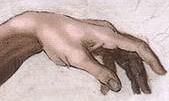
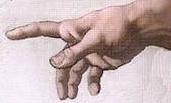 ^
18 Feb 1564: muore Michelangelo
Buonarroti Simoni, 89, pittore,
scultore, architetto e poeta [Rime]
(1475-1564). ^top^
^
18 Feb 1564: muore Michelangelo
Buonarroti Simoni, 89, pittore,
scultore, architetto e poeta [Rime]
(1475-1564). ^top^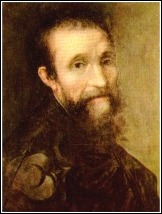 Nel 1534, esule volontario dalla patria asservita, Michelangelo
si stabilisce a Roma e vi rimane fino alla morte (1564). Nell' "Epistolario"
si rammarica continuamente di così lunga vita, ma quello che fa e dice è
un preludio all'arte del domani, in una essenzialità romantica che ritroviamo
nelle fabbriche del Borromini, nelle sculture di A.
Rodin e, prosegue quella pittoricità plastica di cui si sostanziano
il cielo e il suolo di Roma, dalle Fondamenta alla Cupola di S. Pietro,
dal cornicione del Palazzo Farnese alla Piazza del Campidoglio, da S. Maria
degli Angeli a Porta Pia.
Nel 1534, esule volontario dalla patria asservita, Michelangelo
si stabilisce a Roma e vi rimane fino alla morte (1564). Nell' "Epistolario"
si rammarica continuamente di così lunga vita, ma quello che fa e dice è
un preludio all'arte del domani, in una essenzialità romantica che ritroviamo
nelle fabbriche del Borromini, nelle sculture di A.
Rodin e, prosegue quella pittoricità plastica di cui si sostanziano
il cielo e il suolo di Roma, dalle Fondamenta alla Cupola di S. Pietro,
dal cornicione del Palazzo Farnese alla Piazza del Campidoglio, da S. Maria
degli Angeli a Porta Pia. 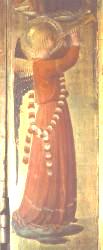 18
18
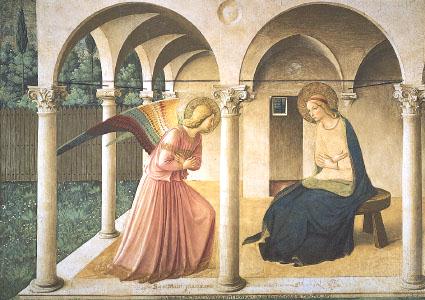 Originally named Guido di Pietro, Angelico was born in Vicchio, Tuscany.
He entered a Dominican convent in Fiesole in 1418 and about 1425 became
a friar using the name Giovanni da Fiesole. Although his teacher is unknown,
he apparently began his career as an illuminator of missals and other religious
books. He began to paint altarpieces and other panels; among his important
early works are the Madonna of the Star (1433) and
Originally named Guido di Pietro, Angelico was born in Vicchio, Tuscany.
He entered a Dominican convent in Fiesole in 1418 and about 1425 became
a friar using the name Giovanni da Fiesole. Although his teacher is unknown,
he apparently began his career as an illuminator of missals and other religious
books. He began to paint altarpieces and other panels; among his important
early works are the Madonna of the Star (1433) and 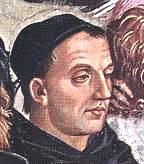 In
Florence and Rome
In
Florence and Rome 






 Il revient s'installer aux États-Unis. Il organise avec Breton
l'exposition First Papers of
Surrealism à New-York. Pour le soir du vernissage, il tend à travers
l'exposition 12 km de fil, obligeant les spectateurs à crapahuter pour accéder
aux tableaux. Une douzaine d'enfants ont fait de l'exposition leur terrain
de jeu. En cas d'objection, leur réponse est un laisser-passer: "C'est
Mr Duchamp qui nous a dit qu'on pouvait jouer ici".
Il revient s'installer aux États-Unis. Il organise avec Breton
l'exposition First Papers of
Surrealism à New-York. Pour le soir du vernissage, il tend à travers
l'exposition 12 km de fil, obligeant les spectateurs à crapahuter pour accéder
aux tableaux. Une douzaine d'enfants ont fait de l'exposition leur terrain
de jeu. En cas d'objection, leur réponse est un laisser-passer: "C'est
Mr Duchamp qui nous a dit qu'on pouvait jouer ici". Il se remarie, pour la vie, avec Alexina “Teeny”
Sattler, à New-York.
Il se remarie, pour la vie, avec Alexina “Teeny”
Sattler, à New-York.